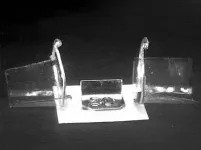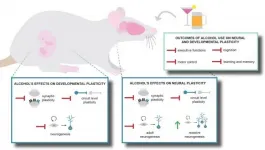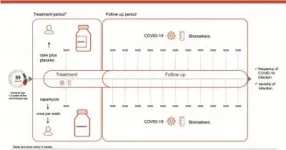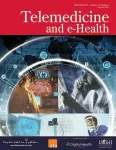Biomarkers that could help determine who's at risk for severe COVID-19 symptoms
2021-02-10
(Press-News.org) One of the many mysteries still surrounding COVID-19 is why some people experience only mild, flu-like symptoms, whereas others suffer life-threatening respiratory problems, vascular dysfunction and tissue damage. Now, researchers reporting in ACS' Analytical Chemistry have used a combination of metabolomics and machine learning to identify possible biomarkers that could both help diagnose COVID-19 and assess the risk of developing severe illness.
Although some pre-existing conditions, such as diabetes or obesity, can increase the risk of hospitalization and death from COVID-19, some otherwise healthy people have also experienced severe symptoms. As most of the world's population awaits vaccination, the ability to simultaneously diagnose a patient and estimate their risk level could allow better medical decision-making, such as how closely to monitor a particular patient or where to allocate resources. Therefore, Anderson Rocha, Rodrigo Ramos Catharino and colleagues wanted to use mass spectrometry combined with an artificial intelligence technique called machine learning to identify a panel of metabolites that could do just that.
The cross-sectional study included 442 patients who had different severities of COVID-19 symptoms and tested positive by a reverse transcriptase-polymerase chain reaction (RT-PCR) test, 350 controls who tested negative for COVID-19 and 23 people who were suspected of having the virus despite a negative RT-PCR test. The researchers analyzed blood plasma samples from the participants with mass spectrometry and machine learning algorithms, identifying 19 potential biomarkers for COVID-19 diagnosis and 26 biomarkers that differed between mild and severe illnesses. Of the COVID-19-suspected patients, 78.3% tested positive with the new approach, possibly indicating these were RT-PCR false negatives. Although the identified biomarkers, which included metabolites involved in viral recognition, inflammation, lipid remodeling and cholesterol homeostasis, need to be further verified, they could reveal new clues to how SARS-CoV-2 affects the body and causes severe illness, the researchers say.
INFORMATION:
The authors acknowledge funding from the São Paulo Research Foundation, the Amazonas State Government, Superintendence of the Manaus Free Trade Zone, Coordination for the Improvement of Higher Education Personnel, the Brazilian Ministry of Health and the National Council for Scientific and Technological Development.
The abstract that accompanies this paper is available here.
The American Chemical Society (ACS) is a nonprofit organization chartered by the U.S. Congress. ACS' mission is to advance the broader chemistry enterprise and its practitioners for the benefit of Earth and its people. The Society is a global leader in providing access to chemistry-related information and research through its multiple research solutions, peer-reviewed journals, scientific conferences, eBooks and weekly news periodical Chemical & Engineering News. ACS journals are among the most cited, most trusted and most read within the scientific literature; however, ACS itself does not conduct chemical research. As a specialist in scientific information solutions (including SciFinder® and STN®), its CAS division powers global research, discovery and innovation. ACS' main offices are in Washington, D.C., and Columbus, Ohio.
To automatically receive news releases from the American Chemical Society, contact newsroom@acs.org.
Follow us: Twitter | Facebook
ELSE PRESS RELEASES FROM THIS DATE:
2021-02-10
If you watch the leaves of a plant long enough, you may see them shift and turn toward the sunlight through the day. It happens slowly, but surely.
Some man-made materials can mimic this slow but steady reaction to light energy, usually triggered by lasers or focused ambient light. New research from the University of Pittsburgh and Carnegie Mellon University has discovered a way to speed up this effect enough that its performance can compete against electrical and pneumatic systems.
"We wanted to create machines where light is the only source of energy and direction," explained M. Ravi Shankar, professor of industrial engineering and senior author of the paper. "The challenge is that while we could get some movement and actuation with light-driven polymers, ...
2021-02-10
CORVALLIS, Ore. - The Columbia River basin will see an increase in flooding over the next 50 years as a result of climate change, new modeling from Oregon State University indicates.
The magnitude of flooding - the term used to describe flooding severity - is expected to increase throughout the basin, which includes the Columbia, Willamette and Snake rivers and hundreds of tributaries. In some areas, the flooding season will expand, as well.
"The flood you're used to seeing out your window once every 10 years will likely be larger than it has been in the past," said the study's lead author, Laura Queen, a research assistant at OSU's Oregon Climate Change Research Institute. ...
2021-02-10
A team of scientists from Immanuel Kant Baltic Federal University with their colleagues from the Institute of Ecology and Genetics of Microorganisms of the Ural Branch of the Russian Academy of Sciences (Perm) studied the effect of trophoblastic β1-glycoprotein in the blood of pregnant women on pro-inflammatory immune cells. Thanks to trophoblastic β1-glycoprotein, a woman's body does not adversely react to the fetus and supports its normal development until birth. It turned out that trophoblastic β1-glycoproteins also suppressed the development of pro-inflammatory lymphocytes ...
2021-02-10
Exposure to some odorless, colorless and tasteless gases, such as nerve agents, can be toxic or even lethal. And having the ability to detect other types of vapors could save people from eating spoiled or rotten food. Easy-to-use portable devices could, therefore, go a long way toward protecting the public. Now researchers reporting in ACS Materials Letters have created a pen-like sensor that changes color when exposed to harmful gases.
Humans can't detect many toxic vapors, such as poisonous nerve agents or volatile amines released from spoiled foods, so a sensor that can notice these gases' very minute concentrations would be useful. Fluorescence-based sensors are a potential solution because they are inexpensive and can reveal trace amounts of compounds. However, some fluorescing ...
2021-02-10
CHICAGO --- Northwestern University's Noshir Contractor will discuss team problem-solving and human systems integration for Mars exploration at the American Association for the Advancement of Science (AAAS) annual meeting.
At a AAAS press briefing at 12 p.m. ET, Wednesday, Feb. 10, Contractor will discuss recent findings and opportunities for social science research on astronauts as exploration advances into deep space. The embargo will lift at the time of the press briefing.
In addition, he will present "Pairing Teams for, and (Re)pairing Teams During, Long-Duration Space Exploration" at 1 p.m. ET on Thursday, Feb. 11 ...
2021-02-10
Political polarization is having far-reaching impacts on American life, harming consumer welfare and creating challenges for people ranging from elected officials and policymakers to corporate executives and marketers.
That's one of the conclusions of a new scholarly paper by researchers from the University of Wyoming and five other universities across the country. The paper appears in the Journal of Public Policy & Marketing of the American Marketing Association.
"I think we're all aware of how political polarization has affected our elections and system of government, but the impacts go far beyond the political arena," ...
2021-02-10
Oncotarget recently published "Evaluation of cancer-derived myocardial impairments using a mouse model" which reported that Myocardial damage in cancer patients is emphasized as a cause of death; however, there are not many murine cachexia models to evaluate cancer-derived heart disorder.
Using the mouse cachexia model that they established previously, the authors investigated myocardial damage in tumor-bearing mice.
When rat cardiomyoblasts were treated with mouse cachexia model ascites and subjected to flux analysis, both oxidative phosphorylation and glycolysis were suppressed, and the cells were in a quiescent state.
These results are in good agreement with those previously reported on cancerous myocardial damage.
The established mouse cachexia ...
2021-02-10
Amsterdam, NL, February 10, 2021 - Neuroplasticity, the remarkable ability of the brain to modify and reorganize itself, is affected by or in response to excessive alcohol, whether through individual consumption or exposure in the womb. It is now well accepted that the birth and integration of new neurons continue beyond development and into adulthood. New discoveries and insights on how alcohol impacts this and other plastic processes are discussed in " END ...
2021-02-10
10th of February, Wednesday, Hong Kong - Deep Longevity, a fully-owned subsidiary of Regent Pacific (SEHK:0575.HK), specializing in the development and the application of next-generation artificial intelligence (AI) for aging and longevity research, today announced the publication of an article in Lancet Healthy Longevity titled "The potential of rapalogs to enhance resilience against SARS-CoV-2 infection and reduce the severity of COVID-19".
While the pandemic continues to unfold, targeted therapeutic solutions for COVID-19 are still not established. The extremely rapid development of various vaccines as a preventative approach provides ...
2021-02-10
New Rochelle, NY, February 9, 2021--The rapid upscaling of a telemonitoring program in which health care providers performed daily telemedicine check-ins on COVID-19 patients faced a unique set of challenges. How these were resolved, and early outcomes are reported in the peer-reviewed journal Telemedicine and e-Health, Click here to read the article now.
"Kaiser Permanente's Virtual Home Care Program (VHCP) was able to rapidly establish a telemedicine-based program for the management of COVID-19 positive patients in the DC and Baltimore Metro regions. Preliminary data suggest that such a program may be effective ...
LAST 30 PRESS RELEASES:
[Press-News.org] Biomarkers that could help determine who's at risk for severe COVID-19 symptoms






